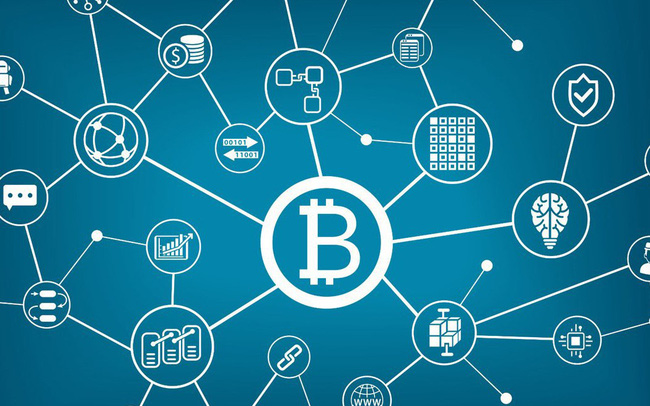What is blockchain?

Blockchain - a keyword that has been so HOT since the beginning of 2017, a technology with many useful applications in various fields such as banking, education, economics, health, gaming, e-commerce. , .. and even agriculture. From Blockchain 3.0 technology to blockchain 4.0 and it's constantly growing around the world, many countries have successfully applied this blockchain technology. So what is blockchain? How does it work? And how is it applied? Along Blog virtual currency offline.
What is blockchain?
Blockchain or ledger (translated into Vietnamese as block chain), its original name is block chain, is a database system containing information, used to store information in linked information blocks. linked together, and managed by everyone involved in the system, instead of an individual third party such as the state or central bank; It also allows secure transmission of data by a complex encryption system, and is expanded over time.
Blockchain was created to prevent data changes in the system, while blockchain technology has a very special feature that transmits data without requiring any intermediaries to confirm. information. Because in the Blockchain system, there are many independent nodes capable of authenticating information in the system without requiring "signs of belief".
Information entered into the blockchain will not be changed and added only with the approval of everyone in the system. This is a system to ensure very high safety for data against the risk of theft, especially sensitive data such as online bank accounts, payment card accounts ... Even if a part of the blockchain system is attacked, the other parts are not affected and continue to operate to protect information.
Blockchain is considered by experts in the world as a main accounting book (or ledger) of a company, where all money-related activities of the company are strictly monitored. In this case Blockchain is a ledger operating in the field of technology, and stored data is digital data.
Main features of Blockchain technology

Blockchain technology is like a ledger recording all transactions that occur in the system. The main features of blockchain are as follows:
Cannot be fake, can't destroy blockchain chains: Blockchian chains are nearly indestructible, and in theory only quantum computers can interfere and decode blockchain chains and it only be completely destroyed when there is no internet on the globe
Immutable: The data in the blockchan is almost immutable (only editable by the person who created it, but with the consent of the nodes on the network) and that data will be kept forever. forever
Data Security: The information and data in blockchain chains are absolutely distributed and secure only the holder of the private key can access that data.
Transparency: Anyone can follow the path of data in the blockchain from address to address and can statistics the entire history on that address.
Smart contracts: are digital embedded by an if-this-then-that (IFTTT) code in the system, allowing them to execute without third parties. The blockchain does not need a third party to join the system, and it ensures that all participants know the contract details and the terms will be automatically executed once the conditions are met.
How is blockchain classified?

In the Blockchain system, there are 3 main types:
Public: This is a blockchain system that anyone can read and write data on. The process of authenticating transactions on Blockchain requires thousands or even thousands of nodes to participate. Therefore, it is impossible to attack this Blockchain system because of the high cost. Examples of public blockchain: Bitcoin, Ethereum ...
Private: This is a blockchain system that allows users to only read data, not write because this belongs to an absolutely trusted third party. This third party may or may not allow users to read data in some cases. The third party is free to decide all changes on Blockchain. Because this is a Private Blockchain, the transaction confirmation time is quite fast because only a small number of devices are required to authenticate transactions. For example, Ripple is a form of Private Blockchain, this system allows 20% of nodes to be fraudulent and only the remaining 80% is stable.
Permissioned: Also called Consortium, is a form of Private Blockchain but adds certain features, combining "belief" when joining Public and "absolute belief" when joining Private. For example: Banks or financial institutions will use their own Blockchain.
Main versions of Blockchain
Currently, blockchain technology has 3 main versions:
Blockchain 1.0 - Currency and Payment: As a primitive and first version of blockchain, the main application of this version is the work related to cryptocurrencies: including currency conversion, remittances and creation set up a digital payment system. This is also a field familiar to many people, sometimes quite a few people mistakenly think Bitcoin and Blockchain are one.
Blockchain 2.0 - Finance and Markets: This is the second version of blockchain, its application is banking and financial processing: expanding the scale of Blockchain, bringing blockchain integration into financial and marketing applications. school. Assets include stocks, checks, liabilities, ownership and anything related to a deal or contract.
Blockchain 3.0 - Design and Operation Monitoring: Currently, this is the highest version of blockchain, with this version, Blockchain technology will cross the border only serving the financial sector, and enter the fields. Other fields like education, government, health and arts ...
Consensus mechanisms in Blockchain
The consensus mechanism in Blockchain can be understood as the way that everyone in the blockchain system can agree on a transaction to occur in the system. Here are the categories
Common consensus mechanism in blockchain:
Proof of Work: This is the most common consensus mechanism, used in Bitcoin, Ethereum, Litecoin, Dogecoin and most cryptocurrencies. This is a consensus mechanism that consumes quite a lot of power.
Proof of Stake: This is a common consensus mechanism in Decred, Peercoin and in the future, Ethereum and many other cryptocurrencies. This consensus mechanism is more decentralized, consumes less energy, and is not easily threatened.
Delegated Proof-of-Stake: This is a common consensus mechanism in Steemit, EOS, BitShares. This consensus mechanism has low transaction costs; extendable; High energy performance. However, it is still somewhat focused because this algorithm selects a trusted person to authorize.
Proof of Work: This is the most common consensus mechanism, used in Bitcoin, Ethereum, Litecoin, Dogecoin and most cryptocurrencies. This is a consensus mechanism that consumes quite a lot of power.
Proof of Stake: This is a common consensus mechanism in Decred, Peercoin and in the future, Ethereum and many other cryptocurrencies. This consensus mechanism is more decentralized, consumes less energy, and is not easily threatened.
Delegated Proof-of-Stake: This is a common consensus mechanism in Steemit, EOS, BitShares. This consensus mechanism has low transaction costs; extendable; High energy performance. However, it is still somewhat focused because this algorithm selects a trusted person to authorize.
Directed Acyclic Graphs: This is the consensus mechanism commonly found in Iota, Hashgraph, Raiblocks / Nano, as a rival of Blockchain.
How does Blockchain technology work?
Blockchain technology is probably the best invention from the Internet itself. It allows exchanging values without trust or evidence to believe. Imagine you and I bet $ 50 for tomorrow's weather in San Francisco. I bet it will be sunny, you bet it is rainy. Today we have three options for managing this transaction:
We can trust each other. Rain or shine, the loser will pay $ 50 to the winner. If we are friends, this could be a good way to bet. However, whether it's a friend or a stranger, it's still not easy to pay for the other person.
We can turn a bet into a contract. With an on-site contract, both parties will be more likely to pay, however, if either of them decides not to pay, the winner will have to pay extra to cover legal costs and possible judgments. take a long time. Especially with a small amount of cash, this does not seem to be the optimal way to manage transactions.
We can resort to a neutral third party. Each of us gives 50 dollars to a third person, she gives the total amount to the winner. But, she can also escape with all the money. So we will choose one of the first two options: trust or contract.
Neither trust nor contract is the optimal solution. We cannot trust strangers and executing contracts requires time and money. Blockchain technology is interesting because it gives us a third, safe, fast and cheap option.
Blockchain allows writing a few lines of code, the program runs on the blockchain, which we both send $ 50 into. This program will keep $ 100 safe and check tomorrow's weather automatically on multiple data sources. Sunny or rainy, it will automatically transfer the full amount to the winner. Each party can check the logical contract, and because it is running on the blockchain, it cannot be changed or stopped. This effort may be too high for a $ 50 transaction, but imagine selling a home or company.
The goal of this section is to explain how blockchain works without discussing in-depth technical details, but enough to give you a general idea of the basic logic and mechanism.
- Blockchain concept. The application of Blockchain blockchain technology
- A number of limitations make blockchain less widely adopted
- What solution to blockchain scalability?
- Disclosure of expected parameters of Ethereum 2.0 improvement
- Lamborghini supercar maker uses blockchain to monitor the supply chain
Operate and exploit advertising by iCOMM Vietnam Media and Technology Joint Stock Company.
Adress: 99 Nguyen Tat Thanh, To 2, Khu 6, Thi tran Tan Phu, Tan Phu, Dong Nai.
Email: phuongtran2191@gmail.com | Tel: (+84) 984654960
Editor in chief: Tran Nha Phuong
Company: Lucie Guillot (Nha Phuong Tran)




